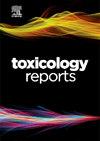鱼类消费模式、油炸和烤鱼产品中多环芳烃和多氯联苯的健康风险评估及缓解策略
Q1 Environmental Science
引用次数: 0
摘要
本研究采用气相色谱-质谱联用(GC-MS/MS)法测定了36种烤鱼和炸鱼制品中13PAHs和6种指示剂多氯联苯的浓度。这项研究在同时测定烤鱼和炸鱼产品中两种持久性有机污染物方面是独一无二的。∑13多环芳烃的浓度和∑6多氯联苯在这些样品从20.80 ±2.06 - -947.65 ±40.85 µg 公斤−1和2.86±0.16 - -46.52 ±0.46 µg 公斤−1,分别。评估了弹性素食者、吃鱼人群和整个人群因食用油炸和烤鱼产品而导致的饮食暴露和人类健康风险。增量一生中罹患癌症的风险为半素食主义者(ILCR)估计,整个人口,和吃人口与饮食摄入量有关这些产品的范围从4.68 × 10−5到1.32 × 10−3,1.06 × 10−3到2.97 × 10−2和1.46 × 10−3到4.12 × 10−2分别。此外,对吃鱼人群评估的烤鱼和炸鱼产品的癌症风险与根据同行评审的印度文献计算的生鱼的癌症风险进行了比较。该研究建议了减少特定鱼类产品中多环芳烃和多氯联苯的减缓战略。该研究还强调了对烤鱼和炸鱼制品中多环芳烃和多氯联苯形成情况进行深入研究的必要性。本文章由计算机程序翻译,如有差异,请以英文原文为准。
Fish consumption patterns and health risk assessment of polycyclic aromatic hydrocarbons and polychlorinated biphenyls in fried and grilled fish products and mitigation strategies
In the present study, the concentration of 13PAHs and the six indicator PCBs was determined through GC-MS/MS in 36 grilled and fried fish products. The study is unique in terms of the simultaneous determination of two types of persistent organic pollutants in grilled and fried fish products. The concentration of ∑13PAHs and ∑6PCBs in these samples varied from 20.80 ± 2.06–947.65 ± 40.85 µg kg−1 and 2.86 ± 0.16–46.52 ± 0.46 µg kg−1, respectively. Dietary exposure and human health risks due to the consumption of fried and grilled fish products for flexitarians, fish-eating population and the entire population were assessed. The incremental lifetime cancer risk (ILCR) estimates for the flexitarians, the entire population, and fish-eating population associated with dietary intake of these products ranged from 4.68 × 10−5 to 1.32 × 10−3, 1.06 × 10−3 to 2.97 × 10−2 and 1.46 × 10−3 to 4.12 × 10−2 respectively. Furthermore, the cancer risk of grilled and fried fish products assessed for the fish-eating population was compared with the cancer risk of raw fish calculated based on the peer-reviewed Indian literature. The mitigation strategies for reduction of PAHs and PCBs in defined fish products have been recommended in the study. The study also highlights the need for in-depth research on PAHs and PCBs formation in grilled and fried fish products.
求助全文
通过发布文献求助,成功后即可免费获取论文全文。
去求助
来源期刊

Toxicology Reports
Environmental Science-Health, Toxicology and Mutagenesis
CiteScore
7.60
自引率
0.00%
发文量
228
审稿时长
11 weeks
 求助内容:
求助内容: 应助结果提醒方式:
应助结果提醒方式:


